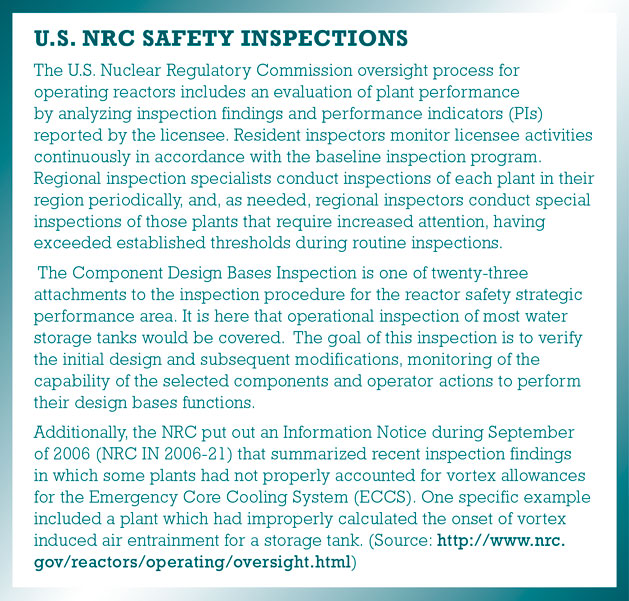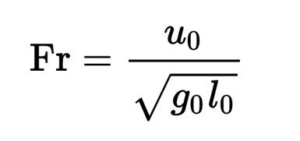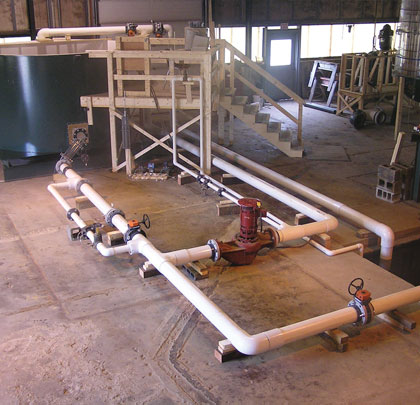Over the past several years many US Nuclear Power Stations have been required to take corrective action to address the potential for air entrainment due to vortex formation associated with flow withdrawal from certain types of water storage tanks. The corrective actions were required to address issues identified during Nuclear Regulatory Commission (NRC) safety system design and performance capability inspections (see sidebar). Tanks of interest are typically associated with a critical component of the emergency core cooling system (ECCS) and can include, but are not limited to, Refueling Water Storage Tanks (RWSTs), Borated Water Storage Tanks (BWSTs), Reactor Core Isolation Cooling (RCIC) Tanks and Condensate Storage Tanks (CSTs). NRC inspection activities have identified several instances in which tank vortex allowances were not properly considered, or were based on an inappropriate vortex methodology.
UNDERSTANDING VORTEXING IN ACTION
Generic flow modeling studies addressing vortexing and air entrainment in pump suction lines have been utilized to develop empirical equations to estimate submergence requirements, minimizing the potential for air-drawing vortices. These studies consider a wide variety of tank geometries and suction configurations operating under steady conditions (flow and submergence). It is well known and documented, however, that site-specific geometry of the suction pipe, including floor and wall clearances, approach flow patterns and transient (dropping water levels) conditions, have a profound influence on vortex formation. As such, it is difficult to reliably and defensibly apply the data available in the literature to each specific installation and associated set of operating conditions.
While numerical modeling techniques, such as Computational Fluid Dynamics (CFD,) can be used to study many flow related problems, they are unable to address air entrainment in storage tanks. CFD can predict the flow patterns within thermal hydraulic structures and typically offer the advantage that the geometry can be quickly modified to study design modifications. It is not yet capable, however, of reliably predicting the persistence and strength of free surface vortices (their unsteadiness and whether they are air-drawing or not) and quantifying the volume of air entrainment. Determining the potential for air entrainment due to vortex formation requires a physical hydraulic model. The accuracy of this method for pump intake structures is well documented and widely accepted.

PHYSICAL HYDRAULIC MODELING AND AIR ENTRAINMENT
For site-specific applications under regulatory scrutiny, physical hydraulic models are useful tools to evaluate the potential for air entrainment due to vortex formation over a range of operating flows and water levels, including transient operating conditions. Additionally, scaled physical modeling can be used to derive modifications, such as vortex suppressors, which allow tanks to be drawn down to water levels lower than that attainable without these structures installed. Over the past several years, a number of nuclear power plants have used hydraulic model studies of their water storage tanks to address the aforementioned issues. These include D.C. Cook, McGuire, Catawba, and Oconee nuclear power plants, among others. Studies involving vortex formation have also been conducted for cooling water intakes, reactor containment sumps, and other specialized intake facilities. All of the aforementioned intake studies required observation and documentation of approach flow patterns, classification of vortices, measurement of inlet losses and quantification of swirling flow in the suction pipes.
HOW IT WORKS
Typical objectives of water storage tank draw down tests include: (1) identification of the water level at the onset of air entrainment, (2) classification of vortex severities at intermediate draw-down water levels, and (3) derivation of vortex suppression devices.

Models involving a free surface are constructed and operated using Froude number similarity since the flow process is controlled by gravity and inertial forces. By keeping the internal Froude number constant, where V is velocity, g the acceleration of gravity, and L the characteristic length, the flow patterns in a scaled geometry will be identical to that in the plant, if viscous and surface tension effects are negligible. When the same fluid is used in the scaled model, it is impossible to keep all relevant dimensionless numbers identical from plant to sub-scale. Therefore, in a tank draw-down study evaluating the formation of vortices, it is important to select a reasonably large geometric scale to achieve large Reynolds (ρVL/μ) and Weber (ρV2L/σ) numbers so as to minimize viscous and surface tension scale effects, respectively, thereby accurately reproducing the flow pattern in the vicinity of the suction. The model scale must, however, be small enough to avoid prohibitive study costs. In general, geometric scales vary from 1:2 to 1:5 for nuclear tank draw-down models.
A LOOK AHEAD
Next month, we’ll conclude by taking a specific look at a typical model suction pipe and the variety of vortexing observed, as well as the results of scale model testing on Duke Energy’s McGuire Nuclear Power Station of Huntersville, North Carolina. ◆
SOURCES
- Daggett, L. & Keulegan, G.H., “Similitude in free-surface vortex formations,” J. of the Hydraulics Division, ASCE, November, 1974.
- Harleman, D.R.F., Morgan, R.L. & Purple, R.A. 1959. “Selective withdrawal from a vertically stratified fluid,” 8th Congress of the International Association for Hydraulic
- Research, August 24 – 29, Montreal, Canada.
Hydraulic Institute Standards, American National Standard for Pump Intake Design, ANSI/HI 9.8-1998. - JPGC2001/PWR-19010, “Air Entrainment in a Partially Filled Horizontal Pump Suction Line,” June 2001.
- Padmanabhan, M. & Hecker, G.E., 1984. “Scale effects in pump sump models,” ASCE J. Hyd. Eng. 110, N. 11, November, 1984.
About the Author:
Andrew Johansson is the director of hydraulic and numeric modeling at Alden Research Laboratory and is on the intake design committee of the Hydraulic Institute (HI). Dr. Mahadevan Padmanabhan, P.E. is a senior consultant and former principal at Alden Research Laboratory and has published widely on nuclear power plant thermal hydraulics and performed generic testing to determine flow characteristics in emergency core cooling system (ECCS) containment sumps (NUREG/CR2758), data from which was subsequently used to revise the NRC regulatory guidelines. Founded in 1894, Alden is the oldest continuously operating hydraulic laboratory in the United States and one of the oldest in the world. Alden has been a recognized leader in the field of fluid dynamics research and development with a focus on the energy and environmental industries. For more information, visit www.aldenlab.com.
____________________________________________
MODERN PUMPING TODAY, June 2016
Did you enjoy this article?
Subscribe to the FREE Digital Edition of Modern Pumping Today Magazine!
![]()


